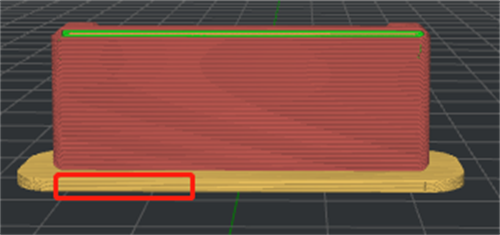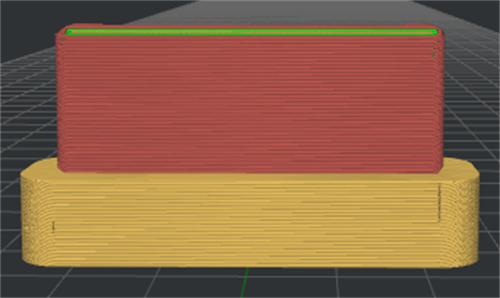(1) Lateral Surface Texture
Lateral Surface Texture refers to the textures can be added to the selected model to overlay the model.
Note: The Texture function only allows you to overlay the texture on the side of model. The top surface will not be covered in texture.
Texture Lighter Color Up means the lighter color in texture will be printed as a new boundary, which will obtain the offset from the original surface’s boundary.

Figure 1: 3D model with texture.

Figure 2: “Texture Lighter Color Up” is enabled.

Figure 3: “Texture Lighter Color Up” is disabled.
Texture Color Normalized means the color in the texture will be normalized when it is used for calculating Lateral Surface Texture XY Offset.
For example, the maximum color pixel is 200, and the minimal color pixel is 50. Once this function enabled, the color will be normalized to be 0-255.
Texture XY Offset refers to the maximum offset distance from the texture to the origin model’s surface in the X/Y direction. A negative offset value will push the surface boundary into the inner structures.
For example, if you set Texture XY Offset to be 1, the color pixel of 255 will convex 1mm. If you set Texture XY Offset to be -1, the color pixel of 255 will concave 1mm. If you set Texture XY Offset to 0, the texture will be ignored.
Texture Resolution refers to the sampling distance when picking up the color in the texture.
Texture Outside Only when this function is enabled, the texture will only cover the outside of the model, and the texture will be applied to the holes.

Figure 4: Texture will not be applied to the holes in model.
(2) Belt Printer
Belt Offset refers to the distance between the model and the conveyor belt.
Place Seam on Belt Edge refers that the start point of Outer Shell, Inner Shell, and Support Infill Outline will be placed at the center of the edges that touch the conveyor belt. If no point is found at the edges, ideaMaker will follow the strategy with the options Layer Start Point Type and Seam Hiding.

Figure 5: The " Place Seam on Belt Edge " Function is Enabled.

Figure 6: The " Place Seam on Belt Edge " Function is Enabled.

Figure 7: The Start Point of the "Inner Shell".

Figure 8: The Start Point of the "Outer Shell".

Figure 9: The Start Point of the " Support Infill Outline ".
Note:
1. It only works for the belt printer. And this option is disabled by default.
2. It can only be used when the Belt Printer function is enabled, and can be found under Printer Settings.
3. It can only work properly with ideaMaker version 4.2.0 or higher. For other versions, it can only work for Outer Shell.

Figure 10: Belt Printer.
(3) Belt Raft
Belt Raft when this function is enabled, ideaMaker will automatically generate a Raft to help the model stick to the printing surface. The Belt Raft is composed of a few layers placed on the printing surface before the model.

Figure 11: Enable Belt Raft
Belt Raft Offset refers to the distance between the model and the extra Raft area around it.

Figure 12: Set " Belt Raft Offset " to 1mm.

Figure 13: Set " Belt Raft Offset " to 5mm.
Belt Raft Gap from Model refers to the gap between the last layer of the Raft and the first layer of model.
Belt Raft Thickness refers to the thickness of the Raft.

Figure 14: Set " Belt Raft Thickness " to 1.5mm.

Figure 15: Set " Belt Raft Thickness " to 10mm.
Belt Raft Speed refers to the printing speed for the Raft.
Belt Raft Flowrate refers to the flow rate of printing the Raft.
Belt Raft Acceleration refers to the printing acceleration speed for the Raft.
Belt Raft Jerk refers to the printing jerk speed of the Raft.
(4) Belt Wall
Belt Wall is the area in the model that touches the conveyor belt. With this function enabled, ideaMaker automatically applies the specified belt wall settings to the outer shells, touching the conveyor belt to increase adhesion to the printing surface.
Belt Wall Minimal Length means the segment will be printed with belt wall settings if the length of the segment is not shorter than the minimum length.
Belt Wall Speed refers to the printing speed for the wall.
Belt Wall Flowrate refers to the flow rate of printing the wall.

Figure 16: The Special Tab.